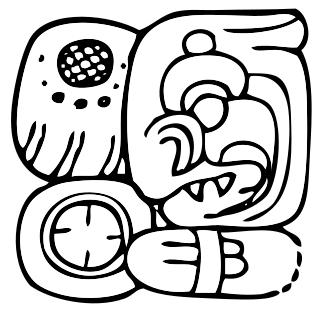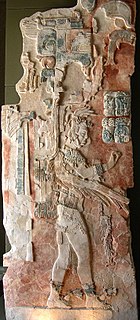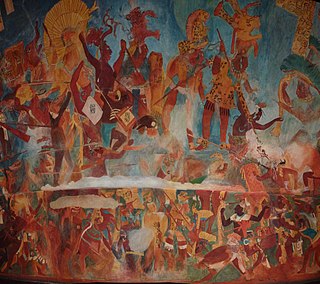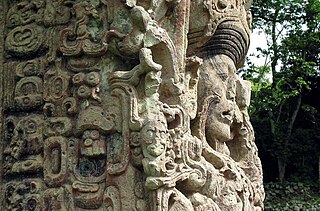 W
WKʼinich Kan Bahlam III,, was an ajaw of the Maya city of Palenque. He ruled c.751. Ruler is not mentioned in any monument at Palenque but only one text at Pomona, that suggest his reign was short or troubled.
 W
WKʼinich Kʼukʼ Bahlam II, also known as Bahlum Kʼukʼ II and Mahkʼina Kuk,, was an ajaw of the Maya city of Palenque. He acceded to the throne on March 4, 764 and ruled until c. 783. He was a son of Kʼinich Ahkal Moʼ Nahb III and Lady Men Nik. Knowledge of him is limited to a few broken monuments: the Tablet of the 96 glyphs, the Creation Tablet, the House B Mural? and Bodega no. 218.
 W
WBolon Kʼawiil II was a Maya king of Calakmul (>771-789?>). His monuments are Stelae 57 and 58 in his city.
 W
WRuler Y was a Maya king of Calakmul. He is also known as Ruler 8 and Bolon K'awiil I. He reigned >741>.
 W
WKʼinich Kʼan Joy Chitam II, also known as Kan Xul II and Kʼan Hokʼ Chitam On II, October 31, 644 – c.721, was an ajaw of the Maya city of Palenque. He took the throne on May 28, 702 (9.13.10.6.8), reigning until c.721. He succeeded his elder brother Kʼinich Kan Bahlam II. Their father was Kʼinich Janaab Pakal I, who had ruled for 68 years, and their mother was Lady Tzʼakbu Ajaw. His possible brother could be Tiwol Chan Mat. Kʼinich Kʼan Joy Chitam apparently reigned for about nine years. He was captured by the Toniná in 711 and was possibly executed by their leader, Kʼinich Baaknal Chaak or was later restored to his kingship. He was succeeded in late 721 by Kʼinich Ahkal Moʼ Nahb III.
 W
WIn archaeology, the classic Maya collapse is the decline of the Classic Maya civilization and the abandonment of Maya cities in the southern Maya lowlands of Mesoamerica between the 8th and 9th centuries, at the end of the Classic Maya Period. The Preclassic Maya experienced a similar collapse in the 2nd century.
 W
WGreat Serpent was a Maya king of Calakmul, a Maya city-state.
 W
WHaʼ Kʼin Xook, also known as Ruler 6, was an ajaw of Piedras Negras, an ancient Maya settlement in Guatemala. He ruled during the Late Classic Period, from 767–780 AD. Haʼ Kʼin Xook was a son of Itzam Kʼan Ahk II, and he ascended the throne following the death of his brother, Yoʼnal Ahk III. Haʼ Kʼin Xook's reign ended with either his death or his abdication in favor of his brother Kʼinich Yat Ahk II; archaeologists and Mayanists have not arrived at a clear consensus. Haʼ Kʼin Xook left behind several monuments, including stelae at Piedras Negras and a stone fragment from El Porvenir. In addition, a stone seat known as Throne 1 and erected by Kʼinich Yat Ahk II records either the death or abdication of Haʼ Kʼin Xook.
 W
WItzam Kʼan Ahk II, also known as Ruler 4, was an ajaw of Piedras Negras, an ancient Maya settlement in Guatemala. He ruled during the Late Classic Period, from 729 to 757 AD. Itzam Kʼan Ahk II ascended to the throne following the death of Kʼinich Yoʼnal Ahk II. Itzam Kʼan Ahk II may have fathered the following three kings of Piedras Negras: Yoʼnal Ahk III, Haʼ Kʼin Xook, and Kʼinich Yat Ahk II. Following Itzam Kʼan Ahk II's demise, he was succeeded by Yoʼnal Ahk III in 757 AD. Itzam Kʼan Ahk II left behind several monuments, including stelae at Piedras Negras and a large mortuary temple now known as Pyramid O-13. In addition, the details of his life and his Kʼatun-jubilee were commemorated on Panel 3, raised by Kʼinich Yat Ahk II several years following Itzam Kʼan Ahk II's death.
 W
WJasaw Chan Kʼawiil I also known as Ruler A, Ah Cacao and Sky Rain,, was an ajaw of the Maya city of Tikal. He took the throne on May 3, 682 and reigned until his death.
 W
WYikʼin Chan Kʼawiil also known as Ruler B, Yaxkin Caan Chac and Sun Sky Rain,, was an ajaw of the Maya city of Tikal. He took the throne on December 8, 734.
 W
WKʼakʼ Yipyaj Chan Kʼawiil was a ruler of the Mayan city of Copán. He was the son of Kʼakʼ Joplaj Chan Kʼawiil. The early period of his rulership fell within Copán's hiatus but later on he began a programme of renewal in an effort to recover from the earlier disaster of the city. He built a new version of Temple 26, with the Hieroglyphic Stairway being reinstalled on the new stairway and doubled in length. Five life-size statues of seated rulers were installed seated upon the stairway. Kʼakʼ Yipyaj Chan Kʼawiil died in the early 760s and is likely to have been interred in Temple 11, although the tomb has not yet been excavated.
 W
WKʼinich Yat Ahk II, also known as Ruler 7, was the last ajaw of Piedras Negras, an ancient Maya settlement in Guatemala. He ruled during the Late Classic Period, from 781 to roughly 808 AD. Possibly a descendant of Itzam Kʼan Ahk II, Kʼinich Yat Ahk II ascended the throne upon the death of his brother, the sixth ajaw of the site, Haʼ Kʼin Xook. While Kʼinich Yat Ahk II presided over the destruction of the rival Maya site Pomona, his reign likely ended with Kʼinich Tatbu Skull IV of Yaxchilan capturing and subjugating Piedras Negras. Itzam Kʼan Ahk II left behind several monuments, including stelae at Piedras Negras, a stone seat known as Throne 1 which records either the death or abdication of Haʼ Kʼin Xook, and Panel 3 which recounts the exploits of Itzam Kʼan Ahk II.
 W
WLa Mar, also known by its Maya name Rabbit Stone, is the modern name for a ruined city of the pre-Columbian Maya civilization located in the state of Chiapas in Mexico. During the 8th century AD, it was an ally of the nearby center Piedras Negras. Stela 12 at Piedras Negras, identifies one of the kings of La Mar as being named Parrot Chaak.
 W
WKʼinich Ahkal Moʼ Nahb III also known as Chaacal III and Akul Anab III,, was an ajaw of the Maya city of Palenque. He took the throne on 30 December 721, reigning until c.736.
 W
WNuun Ujol Kʼinich, was an ajaw of the Maya city of Tikal. He ruled sometime between 794 and 810 and he was probably father of Dark Sun.
 W
WKʼinich Janaab Pakal II, also known as Upakal Kʼinich,, was an ajaw of the Maya city of Palenque. He ruled c.742 and he was probably brother of Kʼinich Ahkal Moʼ Nahb III. There are only few details about his reign like Bodega no. 1144 and portraits on a stucco-covered pier from Temple 19, only date from his reign is from 742, when he installed lord into important office.
 W
WThe known rulers of Tikal, a major centre of the Pre-Columbian Maya civilization in modern-day Guatemala:
 W
WThe Third Tikal–Calakmul War was the third in a series of wars between Tikal and Calakmul, two of the Major superpowers of the Maya Civilization during the classic period.
 W
WThe Tikal–Calakmul wars were a series of wars, mainly between Tikal and Calakmul on the Yucatán Peninsula, but also with vassal states in the Petén Basin such as Copan, Dos Pilas, Naranjo, Sacul, Quiriguá, and briefly Yaxchilan had a role in initiating the first war.
 W
WUaxaclajuun Ubʼaah Kʼawiil, was the 13th ajaw or ruler of the powerful Maya polity associated with the site of Copán in modern Honduras. He ruled from January 2, 695, to May 3, 738.
 W
WWamaw Kʼawiil was an 8th century Maya ruler of Kaan (Calakmul).
 W
WYax Nuun Ahiin II also known as Ruler C and Chitam,, was an ajaw of the Maya city of Tikal. He took the throne on December 25, 768 and reigning probably until his death. He was son of Yik'in Chan K'awiil and brother of 28th Ruler. The monuments associated with Yax Nuun Ahiin II are: Stelae 19, 21 and Altars 6 and 10.
 W
WLintel 24 is the designation given by modern archaeologists to an ancient Maya limestone carving from Yaxchilan, in modern Chiapas, Mexico. The lintel dates to about 723-6 AD, placing it within the Maya Late Classic period. The text of Maya hieroglyphics indicates that the scene depicted is a bloodletting ritual that took place on 5 Eb 15 Mak, 709 AD. The ruler, Shield Jaguar, holds a torch while his consort, Lady Xoc, pulls a rope studded with what are now believed to be obsidian shards through her tongue in order to conjure a vision serpent.
 W
WYoʼnal Ahk III, also known as Ruler 5, was an ajaw of Piedras Negras, an ancient Maya settlement in Guatemala. He ruled during the Late Classic Period, from 758 to 767 AD. Yoʼnal Ahk III ascended to the throne upon the death of Itzam Kʼan Ahk II, who may have been Yoʼnal Ahk's father. He was succeeded by his probable brother, Haʼ Kʼin Xook in around 767 AD. Yoʼnal Ahk III left behind two surviving stelae at Piedras Negras, namely Stelae 14 and 16, the former of which has been called one of the finest niche stelae, according to Simon Martin and Nikolai Grube.
 W
WYuknoom Tookʼ Kʼawiil was a Maya ruler of the Kaan kingdom (Calakmul).